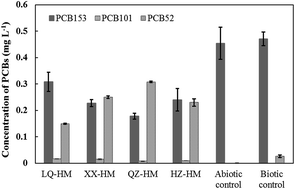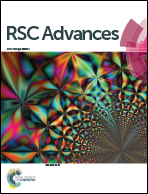Effect of humins from different sediments on microbial degradation of 2,2′,4,4′,5,5′-hexachlorobiphenyl (PCB153), and their polyphasic characterization
Abstract
This study was carried out to evaluate the activity of humins from four different sediments as electron mediators for microbial reductive dechlorination of 2,2′,4,4′,5,5′-hexachlorobiphenyl (PCB153) and to analyze the electron-mediating characteristics of humins. All the humins showed stable electron-mediating activity in microbial dechlorination with the total removal of PCB153 in the range 0.19–0.32 mg L−1. Among the humins examined, that extracted from Qizhen Lake sediment, which was the richest in carbon (4.79%) and contained the highest concentration of Fe (11.04 mg g−1 sample), showed the best performance. Fourier transform infrared analysis showed that all the humins exhibited similar spectra with varying absorbance intensity. A prominent band detected near 1635 cm−1 indicated the presence of C![[double bond, length as m-dash]](https://www.rsc.org/images/entities/char_e001.gif) C and C
C and C![[double bond, length as m-dash]](https://www.rsc.org/images/entities/char_e001.gif) O bonds, which are generally considered to be associated with redox reactions. Cyclic voltammetry analysis confirmed the presence of redox-active moieties in all the humins, with the estimated redox potentials ranging from −0.4 to 0.3 V (versus a standard hydrogen electrode). The polyphasic characterization of humins and the observed stable microbial community composition regardless of humin origin indicated that microbial dechlorination activity is associated with multiple properties of humins, notably Fe content and the presence of C
O bonds, which are generally considered to be associated with redox reactions. Cyclic voltammetry analysis confirmed the presence of redox-active moieties in all the humins, with the estimated redox potentials ranging from −0.4 to 0.3 V (versus a standard hydrogen electrode). The polyphasic characterization of humins and the observed stable microbial community composition regardless of humin origin indicated that microbial dechlorination activity is associated with multiple properties of humins, notably Fe content and the presence of C![[double bond, length as m-dash]](https://www.rsc.org/images/entities/char_e001.gif) O and C
O and C![[double bond, length as m-dash]](https://www.rsc.org/images/entities/char_e001.gif) C bonds and redox-active moieties.
C bonds and redox-active moieties.



 Please wait while we load your content...
Please wait while we load your content...